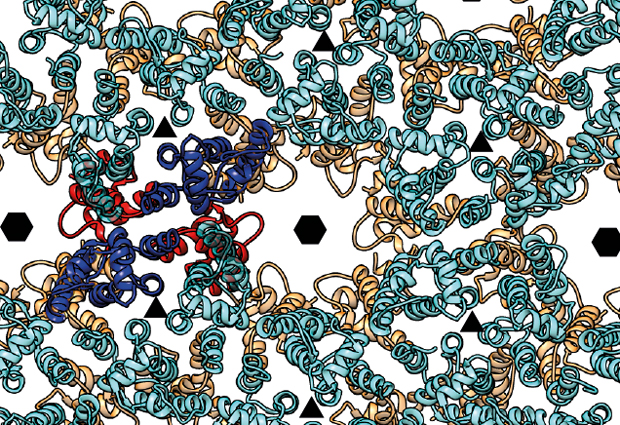Same pieces, different picture
Imagine you are putting together a puzzle, all your pieces align, and when you finish you have a completely different picture from what’s on the cover. An unprecedentedly detailed look at the immature form of HIV has turned up a similar surprise.

This is not the first time the virus’ structure has challenged scientists’ expectations. In the 1990s, Stephen Fuller at EMBL Heidelberg and colleagues obtained the first cryo-electron microscopy images of immature HIV. The researchers were surprised to discover that the virus did not have a regular symmetrical structure, as had been assumed. This unexpected irregularity posed a challenge that would take decades to overcome. It meant that getting a detailed picture of the structure of the virus’ protein lattice was going to be difficult. Two decades on, by optimising both how data is collected at the microscope and how it is analysed, Florian Schur, a PhD student in John Briggs’ lab at EMBL Heidelberg, has now been able to image it at unprecedented detail – and once again the virus had a surprise in store.
The structure is definitely different from what we’d expected
Working with Barbara Müller and Hans-Georg Kräusslich at the Heidelberg University Clinic, in the joint Molecular Medicine Partnership Unit, Schur and Briggs studied the protein lattice that surrounds the virus’ genetic material. After infecting one of the cells in our immune system, HIV replicates, producing more copies of itself, each of which has to be assembled from a medley of viral and cellular components into an immature virus. This is the form that leaves the cell. The protein building blocks that make up the virus are then rearranged into the virus’ mature form, which can infect other cells.
Thanks to their refinement of cryo-electron microscopy techniques, Briggs and colleagues have obtained the first structure of the immature form of HIV at a high enough resolution to pinpoint exactly where each building block sits in the virus’ protein lattice. When they did, they discovered that, like the puzzle forming an unexpected picture, those building blocks are not arranged in the pattern scientists had so far assumed.
“The structure is definitely different from what we’d expected,” Briggs says. “We assumed that retroviruses like HIV and Mason-Pfizer Monkey Virus – which we had also studied before – would have similar structures, because they use such similar building blocks, but it turns out that their immature forms are surprisingly different from each other. At this point, we don’t really know why.”

With this structure in hand, scientists have a basis to probe further. They can use it to decide where to focus efforts for achieving the even greater detail needed to explore potential drug targets, for instance. It will also enable researchers to understand how mutations might influence how the virus assembles. And the techniques themselves can be applied to a variety of questions.
“This approach offers so many possibilities,” says Schur. “You can look at other viruses, of course, but also at complexes and proteins inside cells, with a whole new level of detail.”
In future, the EMBL scientists will use the approach to look at other viruses and at the vesicles that transport material inside cells. They also aim to push the techniques even further, to allow them to see other parts of the viral proteins that are currently beyond their reach, but which they suspect play an important role in HIV maturation.
“In the long term, we’d also like to investigate how drugs which are known to inhibit virus assembly and maturation actually work,” Briggs concludes.
Will there be more surprises along the way?



